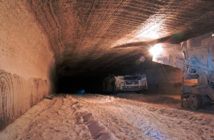By oxfordbusinessgroup.com

While Morocco’s economic growth Eased in 2012, a mix of short-term and long-term Measures to Improve the country’s fiscal health, Alongside strong performance in select Sub-Sectors, Have put the economy on track to see 5.5% growth in 2013, selon to the IMF.
Morocco outstripped all other North African economies in 2011, notching up yearly growth of 4.9%, the IMF reported about in August. Faced with domestic and external challenges, the country’s economic growth to 2.9% Eased in 2012, although a strong uptick Particularly in construction and key industries Such as manufacturing compensated for Decreases in other Sectors, Including agriculture .
Rising global food and fuel prices Weighed heavily on Morocco’s public finances in the first half of the year issue, causing icts economic position to weaken, while falling foreign demand for exports, Particularly from Europe, Reduced fiscal and external accounts.
However, the IMF Expects the current account deficit to Have Fallen from 8% to 7.4% of GDP by the end of 2012, with further Top earmarked for improvement in 2013, as exports from the phosphates and manufacturing industries it increase. In addition, the fiscal deficit is expected to Have shrunk by 0.8 percentage point to settle at 6.1% of GDP by the end of 2012. The deficit is expected to decline to 5.3% further Top in 2013.
Morocco is taking steps to rebuild eroded tax icts and external buffers, led by a revision of public Costly Subsidies for food and energy products, Which year account for 15% of Estimated government spending, and a reform of cash-strapped icts pension system. While the tax reform will take time to put in place, It Has Already Given beens a vote of confidence by key international players, the IMF’s underwriting decision to award a $ 6.2bn Morocco precautionary liquidity line in June.
In another move Aimed at Securing adequate Budgetary support Morocco Issued a $ 1bn, 10-year bond on December 5. The country’s first international dollar-denominated bond, rated BBB-by Standard & Poor’s (S & P), was heavily oversubscribed, prompting Morocco to sell year additional $ 500m 30-year bond, Which Attracted year additional $ 2bn in offers.
Morocco’s agriculture sector, Which Represents Roughly 13% of GDP and 40.3% of employment, was hit hard by poor weather circumstances in 2012. The country’s wheat crop was 39% Reduced year-on-year (yoy) to 5.1m tonnes in the 2011-12 season, meaning the prospect of Morocco faces importing 4m tonnes of additional wheat soft through to May 2013, driving up imports to Their Highest levels in 30 years. The government will be looking to upgrade and aggregation projects, Which are Being Introduced through the agricultural development strategy Green Morocco Plan (TMP) to help boost output of key crops in the medium-term.
Took Morocco aussi icts strides forward in labor-intensive and export-dependent industrial sector in 2012, with The Strongest Performance Recorded in aeronautics and automobile manufacturing.Aeronautic component exports Grew 18% yoy to reach Dh4.64bn (€ 417.1m) by end-September, while automobile exports Increased 7% to reach Dh18.3bn (€ 1.6bn).
The country is working to encourage foreign investment through the development of key industrial free Areas in Production Areas, Including a field under development in Nouaceur dedicated to the aeronautics industry. Bombardier Purchased land for the building of a $ 200m aircraft component manufacturing plant in Nouaceur in June, with construction slated to begin by the end of 2012. The $ 1.1bn Renault car manufacturing plant, opened in February at Which an industrial area in Melloussa, is expected to Produce 340.000 vehicles in 2013, rising to 400.000 per year at maximum capacity.
The output of phosphates and derivative products Stimulate economic growth aussi shoulds in 2013. In the first three quarters of 2012, the value of exports unprocessed phosphate Grew to Dh9.71bn (€ 872.88m), up from Dh9.26bn (€ 832.43m) a year Earlier. A Dh130bn (€ 11.6bn) expansion program Which runs until 2020, AIMS to Increase Production capacity from 30m tonnes to 50m tonnes by Establishing four new mines and building a 300-km pipeline mineral.
Activity across the Sectors, Including social housing initiatives and renewable energy programs, the building sector HAS Boosted, Which Contributes currently 6% of GDP. The government plan to supporting the building of new social housing units 150.000 per year through to 2015, while aussi Increasing the capacity of Both solar and wind power plants to 2,000 MW by 2020 each Stock. A consortium led by Saudi Arabia’s ACWA Power International won a contract in September to construct a 160 MW solar power plant in Ouarzazate, Which is earmarked for completion in 2015.
Many of Morocco’s expansion programs, however, risk Being Somewhat limited by The ongoing credit crunch in the banking sector, with lending tightened considerably in the last three years. The central bank’s efforts to reform the sector and in accordance to Basel III standards shoulds help boost liquidity in the medium-term. Measures Aimed at Increasing the capital adequacy requirement to 12% and core capital requirements to 9% will come into effect in June 2013, Ensuring a solid Basis for lending. In the long term, efforts to ESTABLISH Casablanca as a regional financial hub, Particularly through the special economic zone Casablanca Finance City, shoulds help to expand the financial sector.
Morocco’s economy will continue to be affected by the eurozone crisis, as well as high food and fuel commodity prices, in 2013. However, organic growth in several industries and government efforts to Strengthen Fiscal Policies shoulds build a strong base for future growth.
.






